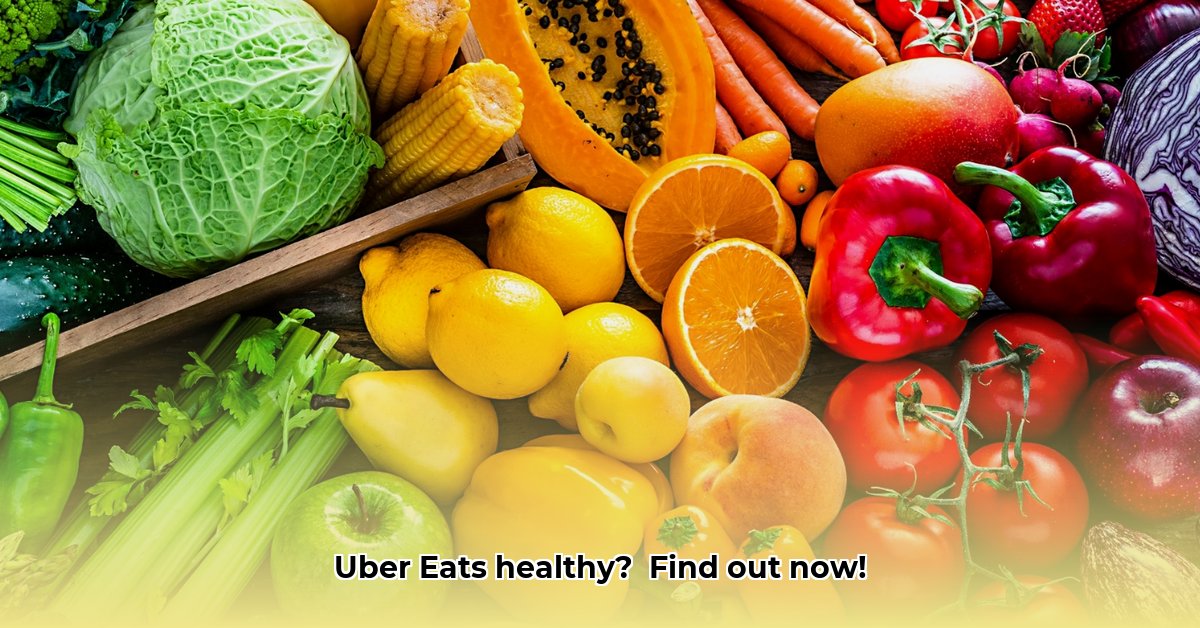Love Uber Eats but worried about those sneaky extra calories? You’re not alone! Ordering in shouldn’t mean sacrificing your healthy eating habits. This guide makes it easy to make smarter choices on Uber Eats, so you can enjoy delicious food without derailing your wellness goals. We’ll show you how to spot the healthier options, manage portions like a pro, and even create satisfying meals that fit your lifestyle. Let’s get started on making Uber Eats your new healthy eating buddy!
Finding Healthy Takeout Near Me: Smart Choices for Your Next Meal
Let’s face it: ordering in is tempting, especially after a long day. But sometimes, that craving for convenience clashes with your healthy eating goals. Fear not! This guide will help you navigate the world of Uber Eats and choose meals that satisfy your hunger and your health conscience. We’ll go beyond simply using the app’s “healthy” filter—which, let’s be honest, can be a bit misleading. Restaurant meals often contain significantly more calories, and hidden fats and sugars, than home-cooked meals, according to numerous studies.
Beyond the “Healthy” Filter: A Dietitian’s Perspective on Uber Eats
Uber Eats’ “healthy” filter is a great starting point, but it’s not a perfect system. It might highlight dishes that seem healthy, but overlook crucial details like the type of oil used, portion sizes, or sneaky sugars and unhealthy fats. Think of this guide as your personal nutritionist’s cheat sheet for smarter ordering. Mastering menu detective skills to spot hidden unhealthy ingredients is essential for making informed choices.
Your Uber Eats Healthy Eating Playbook:
1. Pick Your Battles (Cuisine-Wise): Some cuisines naturally lend themselves to healthier choices. Think vibrant poke bowls overflowing with fresh veggies and lean proteins like salmon or shrimp. Sushi, particularly when you opt for brown rice instead of white rice (a whole grain option), is another winner. Look for grilled options – grilled chicken or fish is always a safer bet than fried. Mexican food can also be a good choice, opting for burrito bowls with grilled chicken and extra salad, or soft shell tacos with grilled fish and plenty of salad toppings. Salads can be healthy, but always check the dressing—creamy dressings often pack extra calories and unhealthy fats. Avoid the temptation of super-sized portions that are likely to sabotage your efforts.
2. Master the Menu Detective Skills: Become a menu sleuth! Read descriptions carefully. Words like “grilled,” “baked,” “steamed,” or “broiled” are your friends. They signal healthier cooking methods that preserve nutrients and minimize added fats. Conversely, “creamy,” “fried,” “breaded,” and “crispy” should raise a caution flag. Pay close attention to serving sizes; a “large” portion might easily undo your hard work. Don’t hesitate to check the restaurant’s website for detailed nutritional information, if available.
3. Vegetables: Your Secret Weapon: Aim for meals packed with veggies. They’re your nutritional superheroes! They add fiber, vitamins, and minerals, all crucial for a balanced diet. If your main dish seems a bit light on the veggie front, consider ordering a side salad or steamed vegetables to round out your nutrient intake. Select steamed vegetables or a side salad as an easy way to increase your daily vegetable and fiber intake.
4. Portion Control: The Art of the Smaller Plate: Even the healthiest dishes can derail your goals if the portions are oversized. One strategy is to order appetizers instead of full entrees—this often presents a surprisingly satisfying portion size. Alternatively, consider choosing smaller sizes or splitting a larger dish with a friend (a great way to also share the cost!). Another handy trick is to immediately plate half your meal and store the rest for later.
5. Hidden Calories—The Sneaky Saboteurs: Watch out for hidden unhealthy ingredients that can easily sabotage your meal. Creamy sauces, excessive salt (sodium chloride), and sugary drinks are lurking culprits. A dish that looks healthy on the surface can quickly become unhealthy with a few extra spoonfuls of heavy sauces. Therefore, always check the ingredients list, if available. Request sauces and dressings on the side to control the amount you use.
Real-World Uber Eats Meal Examples for a Healthier Lifestyle:
Here are a few examples that put our strategies into action:
- The Power Bowl: A grilled salmon or chicken bowl with brown rice, a colorful mix of veggies (think bell peppers, broccoli, spinach), and a light vinaigrette dressing. Request the dressing on the side to control the amount.
- Sushi Success: Choose sushi rolls with lean fish (like tuna or salmon), brown rice, and plenty of fresh vegetables. Avoid rolls that are heavily battered or slathered in creamy sauces. A great variety of choices is usually available.
- Salad Smarts: Skip the creamy dressings. Opt for a light vinaigrette instead. Add protein like grilled chicken or chickpeas to make your salad a more complete and satisfying meal. Consider adding nuts or seeds for healthy fats and extra crunch.
Addressing Your Uber Eats Questions:
- Q: Is everything labeled “healthy” truly healthy? A: Not necessarily! The Uber Eats “healthy” filter isn’t flawless. Use the tips in this guide to make truly informed choices. Remember, appearances can be deceiving.
- Q: Is healthy eating on Uber Eats always more expensive? A: Not at all. Smart choices like salads, veggie-packed bowls, or grilled protein dishes are often comparable in price—or even less expensive—than less healthy options.
- Q: How do you navigate the challenge of inaccurate calorie counts provided on Uber Eats? A: Always cross-reference with the restaurant’s official website, and use your best judgement based on the ingredients and cooking methods described.
The Takeaway:
Ordering in shouldn’t mean sacrificing your health. With a little planning—and these handy tips—you can enjoy delicious and nutritious meals delivered right to your door. Remember, conscious choices are key. You’ve got this! Always seek the guidance of your doctor, dietitian, or other qualified health professional prior to starting a new eating plan.
How to compare Uber Eats calorie counts and macros for healthier choices
Key Takeaways:
- Leverage Uber Eats’ calorie and macro information (when available) to make informed choices about your Uber Eats orders.
- Prioritize cuisines naturally lower in calories and saturated fat, such as Japanese, Mexican (with modifications), and some Thai dishes.
- Focus on grilled or steamed proteins, abundant vegetables, and portion control to optimize your meal’s nutritional value with your next order.
Navigating the world of food delivery apps like Uber Eats can feel overwhelming, especially when you’re focused on eating healthy. How do you make nutritious choices amidst a sea of tempting, but often unhealthy, options? Let’s unpack how to make smarter food choices on Uber Eats.
Understanding Uber Eats’ Nutritional Information
First, let’s talk about the calorie and macro info Uber Eats provides. It’s a helpful starting point, but it’s not perfect. The accuracy depends on the restaurant’s data input. So, don’t rely solely on this data. How to compare Uber Eats calorie counts and macros for healthier choices often involves additional research. You might need to visit the restaurant’s website for more accurate details, especially if you have specific dietary needs or restrictions.
Smart Strategies for Healthier Uber Eats Orders
-
Cuisine Selection: Start by choosing cuisines known for healthier options. Japanese cuisine, with its emphasis on fresh seafood, vegetables, and rice, often presents better choices. Mexican food can be healthy too, if you choose grilled or baked options, avoiding the heavy cream-laden sauces. Thai food can be delicious, but watch out for the richness of some dishes. Look for lighter options like papaya salad or broth-based soups.
-
Dish Selection: Within each cuisine, make thoughtful selections. Look for terms like “grilled,” “steamed,” “baked,” or “broiled” which typically denote healthier cooking methods. Prioritize dishes that feature plenty of vegetables and lean protein sources. Avoid those loaded with creamy sauces or excessive salt.
-
Portion Control: Uber Eats portions can be generous. Ordering an appetizer instead of a main course, or splitting an entree with a friend, can significantly reduce your calorie intake. Consider the nutritional values relative to your daily allowance.
-
Boosting Vegetable Intake: Even the healthiest dishes can benefit from an extra veggie boost. A side salad or steamed vegetables can add fiber and essential nutrients to your meal.
-
Scrutinize Descriptions: Don’t just glance at the menu. Read the descriptions carefully. Hidden ingredients might sabotage your health goals. Pay close attention to sauce choices, added fats, and excessive sodium.
-
Hydration is Key: Opt for water, unsweetened tea, or sparkling water instead of sugary drinks. These choices can significantly reduce your calorie intake.
Example Meals for Calorie Conscious Choices
- Japanese: A salmon teriyaki bowl with steamed brown rice and a side of edamame.
- Mexican (modified): A grilled chicken fajita salad with plenty of vegetables, and a light vinaigrette dressing.
- Thai (healthy choice): A lean chicken or tofu stir-fry with plenty of vegetables, and hold the heavy sauces.
Addressing Common Concerns
- Inaccurate Calorie Counts: Be aware that calorie counts may occasionally be inaccurate. Use the provided information as a guideline, but exercise your best judgment too.
- **Limited
- Mini Bento Boxes For Packing Kids Snacks And Small Meals - December 27, 2025
- Small Bento Box Makes Packing Lunch Easy and Fun Again - December 26, 2025
- Adult Bento Box Lunch Ideas For Quick Healthy Portable Options - December 25, 2025










